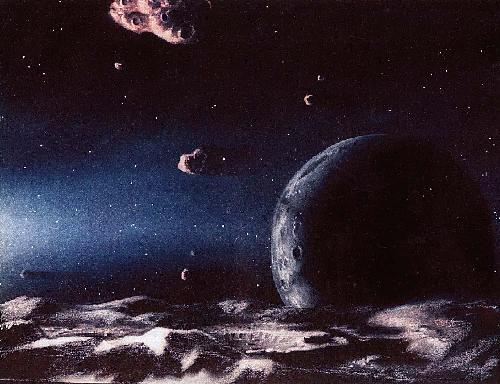
| Recent Research |
|---|
Optical-Infrared Colors of Kuiper Belt Objects
Our previous measurements show a wide range of optical colors among the
KBOs. Does this
spectral diversity extend to other wavelengths and,
if so, what can we learn about KBOs from it?
We have taken broadband JHK photometry from the Keck telescope together with broadband BVRI photometry from the UH 2.2-m telescope to search for optical-IR spectral diversity among the Kuiper Belt Objects. We again find a wide range of spectral types.
Keck Near IR Spectrum of 1996 TL66
What can we learn from true optical-IR spectra?
We have taken optical and infrared spectra of 1996 TL66 using the Keck and MMT telescopes.
Large Kuiper Belt Objects
We conducted a wide-field survey using the
UH 8k CCD.
Results of this 50 sq. degree survey include the discovery of
the Scattered KBO class (exemplified by
1996 TL66), observational constraints
on the size distribution, radial extent and maximum size of the KBO distribution, plus a
set of objects bright enough to permit meaningful physical measurements.
Heat from a Centaur
With this in mind, we measured heat from
1997 CU26
and used it to estimate the albedo and size of this Centaur.
Comet Nucleus Rotation
I reviewed
cometary rotation
for the Hale-Bopp Conference in Tenerife,
February 1998.
Keck Survey of Faint Kuiper Belt Objects
We used the Keck 10 meter telescope to conduct an
imaging survey
that reaches below magnitude 26.
Dust in Comet Hale-Bopp
How much mass was ejected from Comet Hale-Bopp?
Read all about
large dust particles
observed with the JCMT.
Annual Reviews of Earth and Planetary Science
Can you summarize what we know about the Kuiper Belt
in less than 30 pages? Well, here's my attempt, for
the 1999
Annual Reviews
of Earth & Planetary Sciences.
Protostars and Planets IV Review
Can you do it again using completely different words?
PPIV
Protostars and Planets IV.
ESO Workshop Review of Kuiper Belt Science
Tired of those painfully long reviews? How about a review
as short as I can make it without losing important
issues? This one is for the 1998 November
ESO workshop in Garching, Germany.
The Number of Scattered Kuiper Belt Objects
How many
Scattered KBOs are there? Based on TL66, we guessed
about 6000 SKBOs larger than 500 km even in 1997. With more
SKBOs recently discovered in our large-format CFHT survey, we reach a
better estimate of the population.
Water in Centaur 2060 Chiron
We detected water in the reflection spectrum of
2060 CHIRON .
Jupiter's Trojan Asteroids
What is the size distribution and number of Jovian Trojan asteroids?
These bodies have been known for about a century but have not
received much observational attention. In truth, they are potentially
very interesting because they may consist of Jupiter family planetoids
that have been trapped at 5 AU since formation. They could be as ice
rich as comets. They could even be comets.
Here are results from a serendipitous CCD
survey.
Solar Polar Rays
Solar polar rays have been known for a long time but it turns out that they
are neither polar nor rays. New observations using SOHO data show that the
polar rays are high altitude plasma above extended active regions (near the
solar equator, not the poles). They are seen only in projection. Once
you get your brain around the geometry, it's obvious. These features have
implications for study of the true polar coronal holes because they cover
them up near solar maximum.
Bright Centaur Survey
We undertook a survey for bright Centaurs and Kuiper Belt Objects using a
modified Baker-Nunn Camera in Australia. Our
paper
discusses the luminosity
function of the Centaurs and makes predictions for the total number
of such objects awaiting discovery (hint: it's a lot).
Last updated February 2001
 |
Kuiper Belt |
|---|
Last Update January 2001